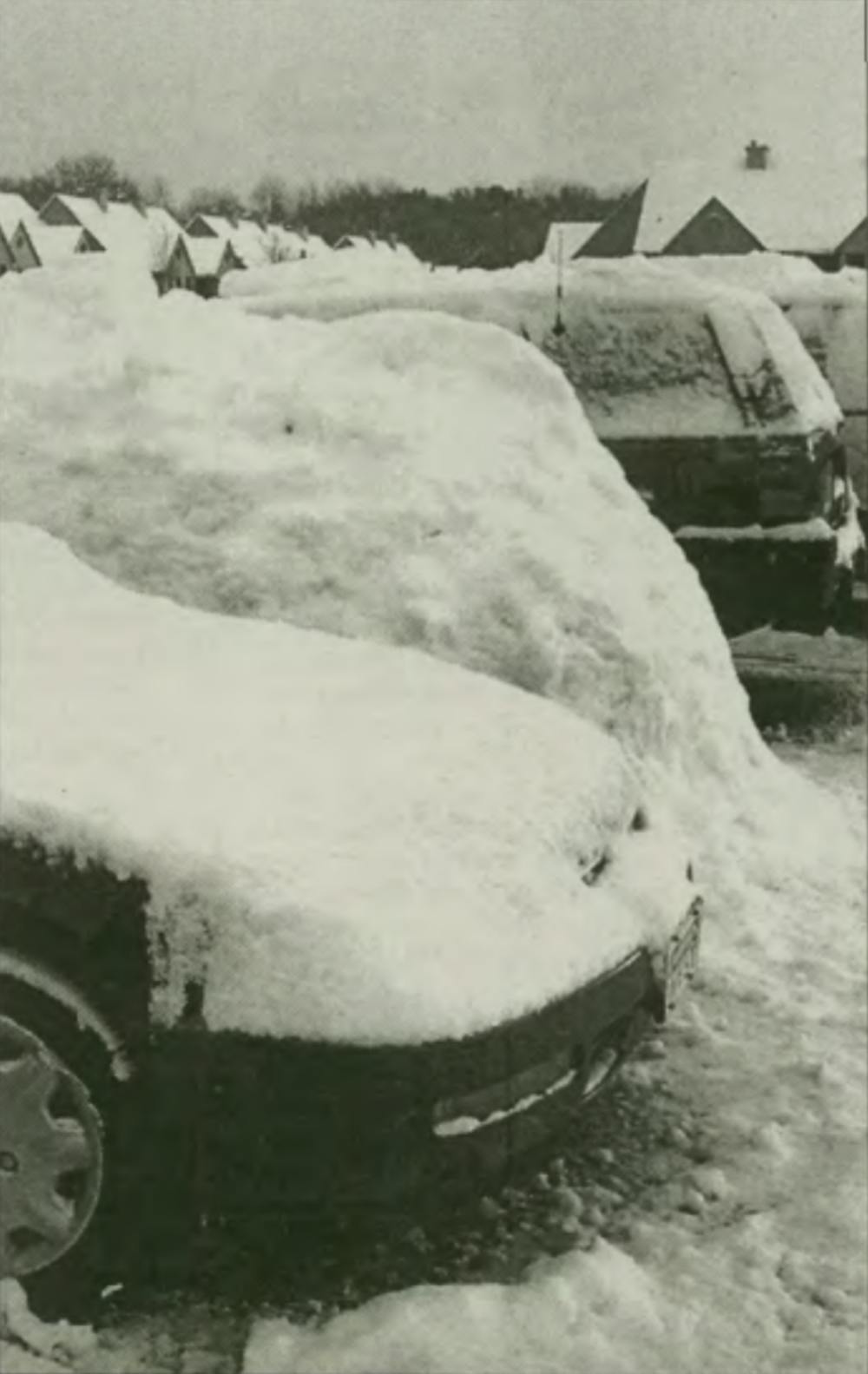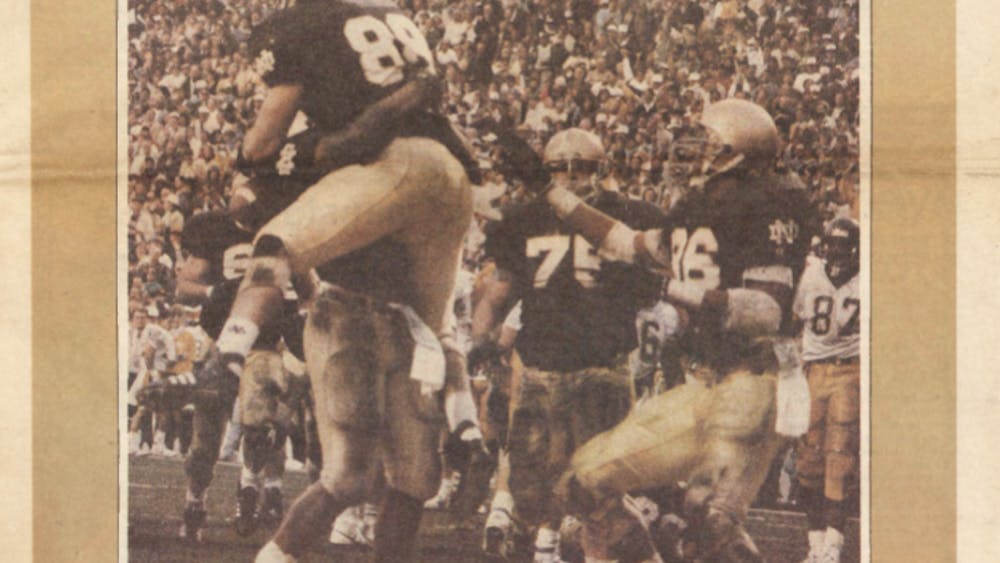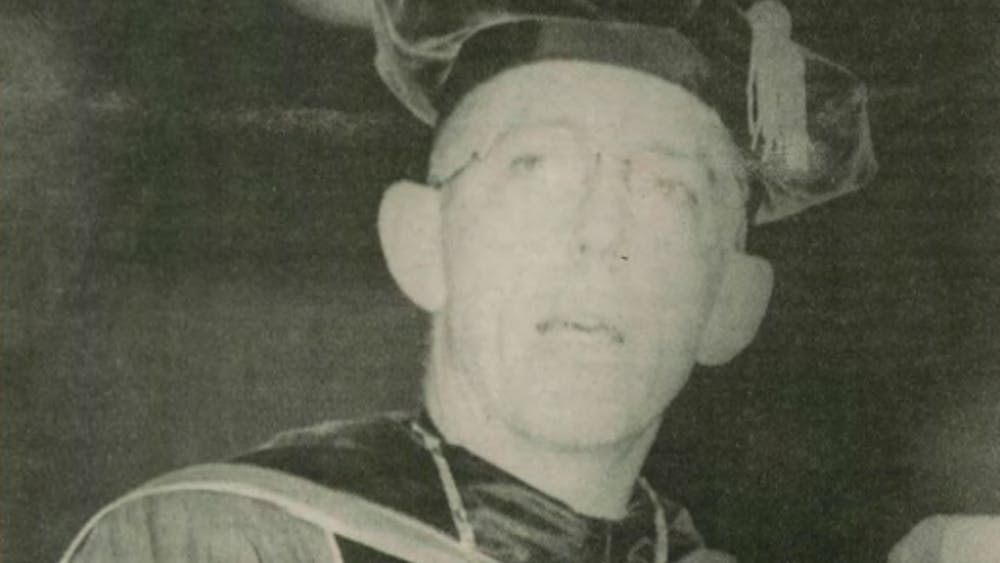
Step into a captivating exploration of campus antics, where playful pranks collide with serious repercussions. From the daring theft of a bust that sparked a law enforcement hunt to a culinary prank with a costly aftermath, explore the fine line between tradition and transgression. Venture further with a satirical twist in The Absurder, where humor skewers the absurdities of university policies and culture. This compilation from the archives invites you to reflect on the complexity of pranks — a blend of creativity, camaraderie and sometimes unintended outcomes. Uncover the stories that have shaped the dialogue between humor and harm at Notre Dame across decades.
Pranks and Crimes
Sept. 25, 1968 | Observer Staff | Sept. 12, 1984 | Bob Vonderheide | Sept. 26, 1984 | Margaret Fosmoe | Sept. 5, 1895 | Mark Pankowski | Researched by Cade Czarnecki
While interpretations of their actions have varied, numerous Notre Dame students have fancied themselves pranksters over the years.
In 1968, the front porch of Badin Hall was mysteriously painted white overnight. Although historical accounts suggest the paint job was subpar, it completely changed the aesthetic of Badin.
Allegedly, the University had previously denied requests from residents of Badin to repaint the porch, so it was assumed that a proud resident took matters into their own hands. Only two pieces of evidence were discovered that indicated the possible perpetrator behind the whitewashing of the structure: size nine footprints in white paint alongside two handprints.
1984 witnessed one of Notre Dame’s most notable pranks, though it might be more rightly called a theft. The iconic bust of Knute Rockne was stolen from the Rockne Memorial.
The whereabouts of the bust were unknown until students reported seeing it at a graduation party on the shore of Lake Michigan. Soon after the theft, a ransom note showed up at the offices of The Observer that said the bust would not be returned “till students have their beer.” A photo showing the bust dressed in sunglasses on a beach accompanied the note.
More photos from the thieves turned up in the coming weeks, including one of the bust in a Purdue shirt next to a West Lafayette road sign. Suspicion then shifted toward a Purdue graduate student who had studied at Notre Dame during their undergraduate years, despite a lack of concrete evidence.
The bust suddenly reappeared during the chaos of a pep rally. The administration was relieved, but the feeling was short-lived. Three days later, the smaller replica bust that had replaced the original one in the Rockne Memorial also disappeared. In its place was a jack-o-lantern and a note that read “here’s a buck for your troubles.”
In yet another episode of somewhat misguided pranks by students, three irreplaceable stations of the cross were stolen from the St. Edward’s Hall chapel in 1985. They were hand-carved and had resided in the chapel for over 60 years.
While the pranksters assuredly thought they were committing this act in humor, the St. Edward’s community was outraged. Three small, minimalist crosses replaced the missing ones. Their plain nature served as a reminder of the theft going forward.
‘Jest a Minute’: When do pranks go too far?
Sept. 13, 1984 | Mark Potter | Dec. 10, 2009 | Matt Brown | Nov. 12, 1996 | Shannon Dunne | Oct. 30, 1997 | Derek Betcher | Researched by Thomas Dobbs
The distinction between humor and harm, between playful antics and vandalism, poses a challenge for college campuses. Pranks, a staple of college life, serve as a testament to the creativity and camaraderie of students, but they also pose ethical and legal dilemmas that challenge administrative and student perspectives alike.
Mark Potter, in his reflective piece, argues the 1984 theft of the Rockne bust from the Rockne Memorial crossed the line — a prank that escalated to involve the Los Angeles Police Department. “Pranks are not done with the intent of hurting someone, rather they are done in a spirit of fun, while a crime is done only for one’s personal gain,” Potter writes.
Pranks, as described by Potter, often emerge from a place of boredom or in response to restrictive policies, such as the then-new alcohol policy at Notre Dame.
Yet, pranks can have significant consequences and cause considerable damage. One such incident in 1997 involved pranksters baking parmesan cheese in toasters and microwaves to create foul odors, resulting in $10,000 in damages, as reported by the senate.
The Scene section of The Observer, through its advice column, conveys the simultaneous enthusiasm and caution surrounding pranks. In addressing a query from “Frustrated in Badin,” Matt Brown supports the continuation of a prank war, emphasizing the importance of keeping pranks light-hearted. “The most important thing to remember is to make sure no lasting damage will be done,” the column advises, while also humorously warning of the potential for a dramatic escalation in prank warfare.
The Absurder
April 1, 1977 | Observer Staff | April 1, 2004 | Observer Staff | Researched by Thomas Dobbs
The Absurder edition of The Observer, Notre Dame's own twist on April Fools', never fails to deliver a punch of humor right where it's needed.
In an audacious piece, the University's president, portrayed as “Dr. Freddy Hesburgher,” makes a compelling plea for a tuition hike. With a straight face, he defends his private jet use: “I need it for my job. How can I be a world savior if I can't see the world I'm supposed to save?” This jest at the administration’s expense highlights the absurdity of using “high-minded” justifications for raising student costs.
The satire peaks with an outlandish claim that Notre Dame has been diverting tuition funds into a secret nuclear weapons program. Chief weapons inspector “Duke Nukem” reveals the bizarre logic underpinning their investigation. “There was no way that much money could be funneled into education,” Nukem said. “We narrowed it down to either paying off the remainder of Bob Davie’s contract or nukes before we saw those kids from Zahm. It’s quite sad what radiation can do to humans.”
This scenario satirizes the absurdity of escalating tuition fees, insinuating that the funds could be misallocated to anything as improbable as a University-led nuclear arms race.
Hidden in the ridiculous lies a bit of truth: the jest underscores the real extravagances of college sports programs and nods to Notre Dame's expensive payouts, such as the nearly $19 million paid to Charlie Weiss in 2009 after his firing. The piece suggests that the University's financial priorities can sometimes seem as fantastical as funding a nuclear arsenal.
The Absurder has also touched on the peculiar demographics of Notre Dame's sporting events in a piece that discusses a shift of home basketball games to the Fort Wayne Coliseum.
This move, allegedly to overcome Notre Dame’s infamously older crowds, is supported by Coach Hike Frey's observation: “The reception they gave our boys last week was outstanding.” Furthermore, a Hooters was reportedly added next to the Coliseum to ensure fans “are always yelling because they are too drunk to know what’s going on.”
Every piece within The Absurder acts as a mirror, where satire not only sketches the real or imagined issues plaguing the University landscape but also showcases humor's powerful role in dissecting and digesting campus life. The special edition illustrates how laughter can serve not just as a source of entertainment, but also as a catalyst for critical thinking and discussion about significant academic and administrative concerns.










